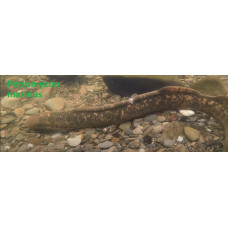Petromyzontidae is a family of fishes of the class Cephalaspidomorphi. Jaws absent, mouth sucking in the form of a funnel, equipped with horny teeth. The body is naked, slimy, worm-like, chorda is retained for life, there is no bone tissue in the skeleton. Paired fins are absugnut. On the sides of the body 7 gill openings that open into gill sacs. Development with metamorphosis.
Inhabit the seas, rivers, streams, most are exoparasites of fish. The sandfly larva has a mouth in the form of a triangular slit, eyes are poorly developed. The larval period lasts from 2 to 5 years. There are 24 known species. They are distributed in temperate latitudes of the northern and southern hemispheres. Marine and freshwater forms.
Lead a parasitic and non-parasitic lifestyle. Petromyzon marinus is known to parasitize fish. Forms passerine and residential forms. Reaches a length of 1 m. Lampetra fluviatilis is widely distributed in European rivers. It reaches a length of 40 cm. It leads a passageway way of life. Freshwater life forms are known from Ladoga and Onega lakes and some rivers of the Baltic Sea basin. May parasitize fish. After spawning, adults die. Lethenteron kessleri inhabits water bodies of Siberia. It is of no commercial importance.
Petromyzontidae, as well as hagfish, differ from fish primarily by the absence of jaws. The mouth of adult lampreys round, turned into a sucking funnel, on the walls of which, as well as on the tongue, are located horny teeth. Nasal opening in lampreys only one, unpaired, but the eyes as many as three. True, the third eye is not a real eye: it has no lens, and it is only able to perceive light sensations. This parietal eye - a very ancient organ, inherited by lampreys from their ancestors. Behind the head on each side of the body lampreys have 7 gill openings. Together with fossil forms, lampreys form an independent class of vertebrates Cephalaspidomorphi. Modern lampreys are represented by one family, including 30 genera, and inhabit temperate latitudes of the northern and southern hemispheres. In Russian waters there are lampreys with eyes located on the sides of the head, and the second dorsal fin merges with the caudal fin, such lampreys inhabit only in the northern hemisphere.
Petromyzontidae
Tags: petromyzontidae



